Right now, in virtual conference calls everywhere, exhausted higher education professionals are working their tails off.
College and universities were royally slammed, to put it nicely, by the effects of the COVID-19 pandemic’s sudden shutdown of daily life. While their gratitude abounds for health and for security and for the essential people out on the ground doing work and saving lives, most higher education communications teams are also facing incredible and—you’ve heard this word a million times by now, but it’s still the right one—unprecedented circumstances.
Modern Tribe has documented crisis response advice every website can use, but we want to take a moment to recognize the specific UX and content questions higher education web teams are asking. There’s never an ideal time for a pandemic, but typical higher ed challenges have been exacerbated by the end-of-academic-year timing and the temporal nature of many constituents’ physical relationship to campus. (Hi, not to mention how hard it is to actually deliver on experiential-based pedagogies from one’s living room.)
We called upon our higher education experience as a company and as individual practitioners, as well as that of experts working in the field, to further define these challenges and use them as a lens through which to examine examples on current sites. Even though everyone is hustling to keep up with the latest changes, it’s encouraging to know that we’re all in this together. We have an opportunity to use our roles in the digital space to support our communities in new and more impactful ways. Let’s dig in.
Colleges face unique challenges in a crisis
Even in the best, most pandemic-free circumstances, higher education communications teams face challenges specific to their industry’s shape and social influence. The following four are particularly relevant during the COVID-19 crisis. Here’s why.
The challenge: Audience range.
Colleges and universities have a huge number of audiences that represent a broad range of demographics—parents, students, prospective students, faculty, staff, leadership, administrators, boards of trustees, alumni, general public, institutional peers, emergency responders, legislators, community members and more. These audiences often have competing needs and priorities.
In the pandemic, comms teams have struggled to enforce a centralized messaging system as collegewide leadership scrambles to make decisions and, though well intentioned, communicate them on their own (e.g., Residence Life sending out an email to students outlining the process for moving out when students hadn’t yet been told they even needed to move out… gulp). This challenge has also reared its many heads while planning .edu site content. How do you create a UX and content strategy that keeps everyone on the same page? How can digital solutions support communication efforts?
The challenge: Accessibility.
The breadth and depth of this audience means there’s also a wide spectrum of abilities, access and availability that colleges must consider. During COVID-19, some residential students have no internet access off campus. There are homeless students with no home to go back to, and there are students with no devices or just their smartphones, which makes distance learning a challenge. International students who went home might not be able to access certain sites or technologies, or their parents may have a language gap. Students and staff who need assistive devices might not have access to them at home. Faculty and staff are likely ill-equipped and ill-prepared to teach and work remotely. And the list goes on.
The challenge: Breadth of messages.
There’s so much to be communicated to audiences at this time, and it needs to be communicated fast. To call this difficult in a college’s highly democratic environment is… an understatement. Standard announcements notwithstanding, many of these institutions also have hospitals attached, adding exponentially more messaging challenges between two sides of the house that should be, but rarely are, aligned. Commencement, career fairs, senior theses events, admitted student days, recruiting travel, study abroad, summer community education—these essential moments in the college life cycle need to be changed, postponed or canceled, and those decisions need to be communicated and supported. And that’s not all (sensing a theme here?).
The challenge: Delivery efficacy.
Message fatigue is real, especially for students and parents. How do you ensure they got your message? How do you support them effectively and with care? How do you expect accountability if they can just say they didn’t read it?
Building a thoughtful information architecture on .edu pages can be a challenge when it’s unclear how audiences are receiving messages through other channels. Teams must balance direct information with empathy for graduating students’ and parents’ grief over missing out on such a long-awaited life moment, for now anyway. Social media is a helpful tool but also a place where many colleges and universities find themselves to be punching bags for understandably frustrated constituents. And still, there’s more.
Solutions for higher education websites
To support higher education professionals who are navigating this totally wild and intense and (let’s be real) %$#@ stressful time, we’ve rounded up some examples of college and university websites that are achieving elements of this on-the-fly work well. Let’s break down why certain aspects of their UX or content strategy excel and what we can learn from each.
HOMEPAGE
A+ example: Vanderbilt University
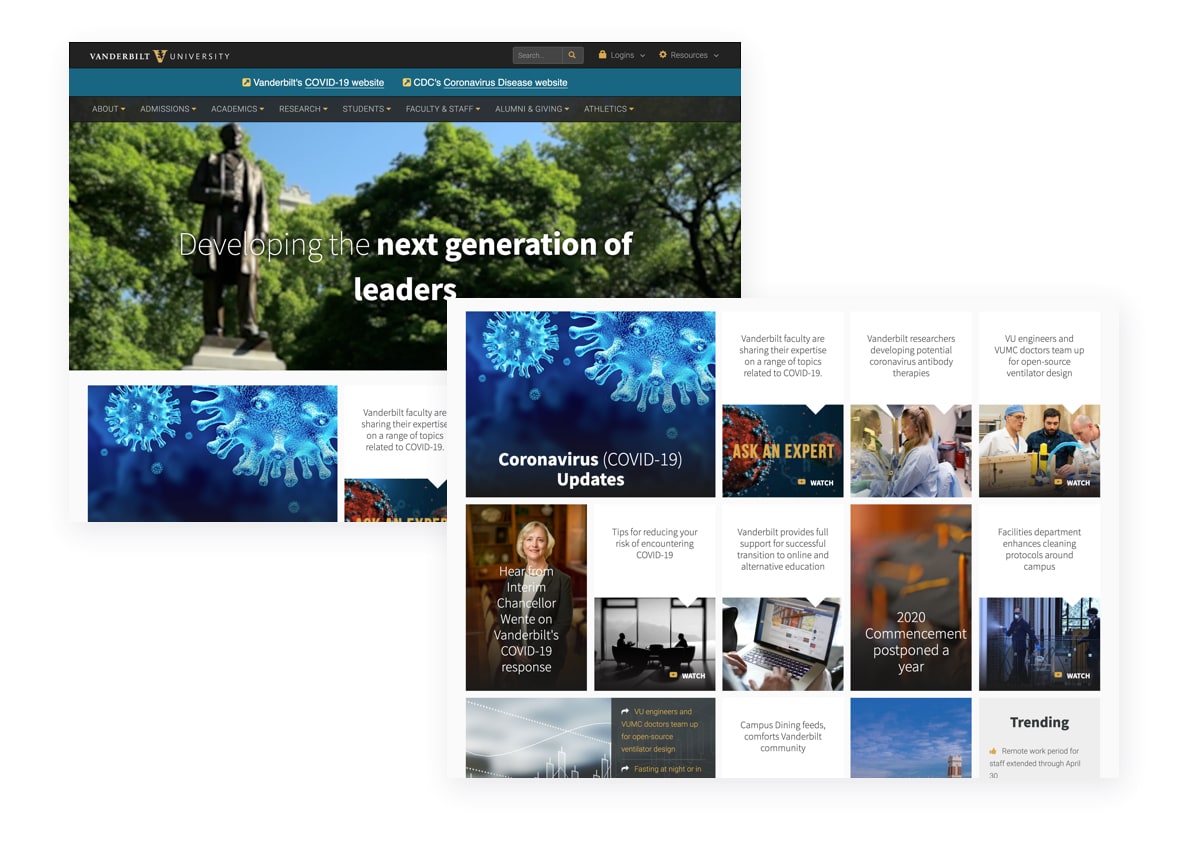
Lesson 1:
Vanderbilt’s homepage is a COVID-19 takeover. The page features must-have information in an easily accessible format, as well as experts’ take on the virus, what Vanderbilt researchers are doing, stories of engineering students and doctors working on open source ventilator designs, exposure reduction tips, social distancing tips, and the changes to cleaning protocols in the buildings.
Solves for: accessibility, audience range, breadth of messages, delivery efficacy
Why it works: A homepage dedicated to the human stories of the crisis is more usable and more impactful than a cold narrative or a wall of links. Colleges are packed with experts, who are packed with knowledge. Find content opportunities to share their expertise.
Lesson 2:
The alert bar spans the entire public website, including the primary .edu domain and many subdomains.
Solves for: accessibility, delivery efficacy
Why it works: College audiences, unlike customers in many other industries, are coming to the website through an expansive range of entry points and perspectives. An alert bar that is present always and everywhere improves the chance that the audience that needs to receive your announcement actually does. Make your alert succinct, prominent and always viewable.
CORONAVIRUS INFORMATION PAGE
A+ example: Louisiana Tech University
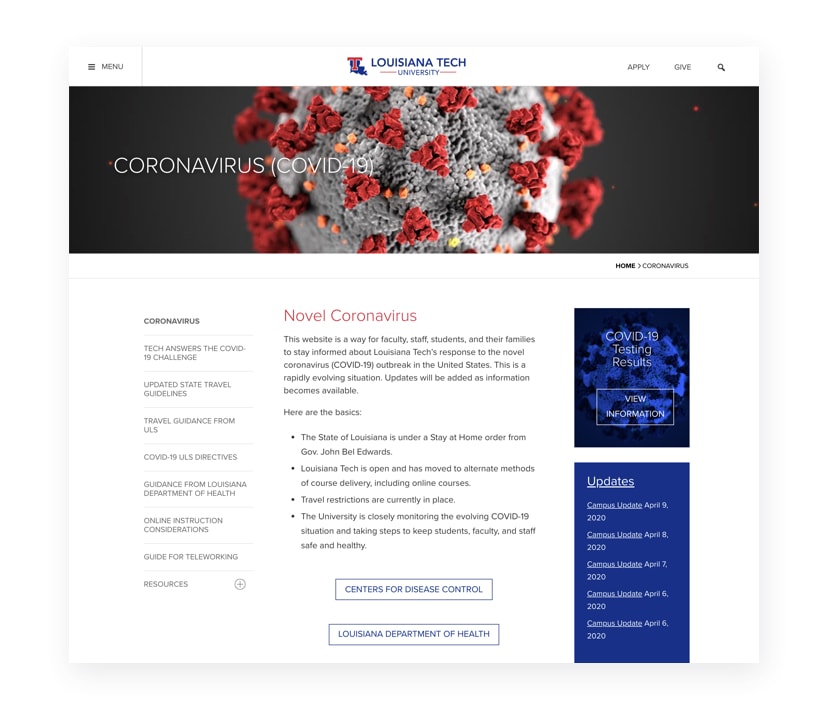
Lesson 1:
Louisiana Tech’s COVID-19 response page is topped by “the basics,” a very TL;DR approach that’s much appreciated amid this paradox of information overload/murkiness.
Solves for: accessibility, audience range, breadth of messages, delivery efficacy
Why it works: The university’s messaging manages to strike that elusive balance between informative and empathetic. It’s important to maintain plain language wherever possible to avoid language comprehension challenges or potential errors with automatic translation. Write in a voice that feels human-to-human.
Lesson 2:
The links on the response page hit all the high points and provide guidelines for all top-level audience types.
Solves for: audience range, breadth of messages
Why it works: The page blends good UX and design to direct attention to key info. A sidebar in a contrast color, for example, only links to campus updates with date information for each. Work the components your CMS provides to denote visual hierarchy and time stamp important updates.
Example of note: Cornell University
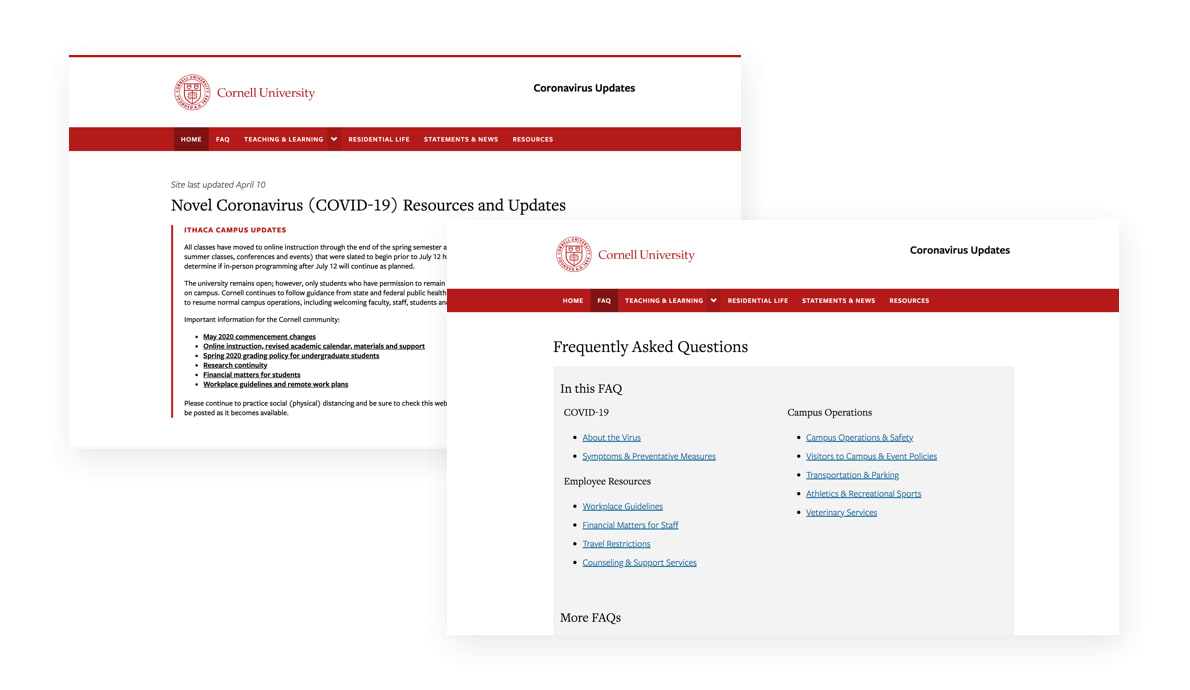
Lesson:
Cornell has created an entire Coronavirus Updates website, which includes an FAQ page. When an answer to a frequently asked question on that page is updated, the question gets an “Updated DATE” tag placed beside it.
Solves for: breadth of messages, delivery efficacy
Why it works: The website approach empowers the communications team with more room to provide and space out messages. Organize FAQs by topic and/or audience, and make it easy for returning visitors to know if something has changed.
Example of note: University of Washington
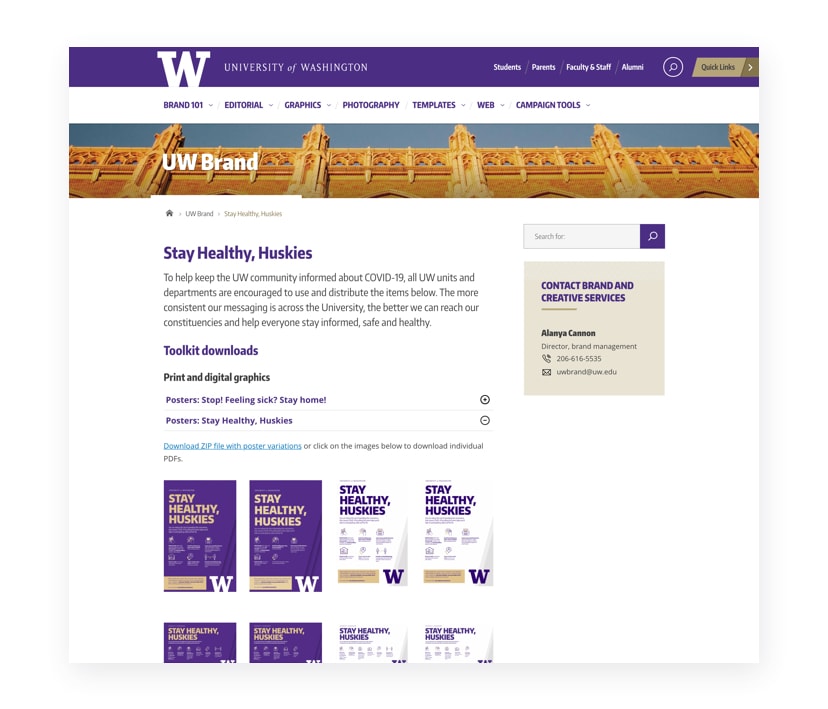
Lesson:
At the bottom right-hand column of the University of Washington’s coronavirus update page, the university provides a link to a toolkit of COVID-19-related health and safety posters, digital screens and pre-made social media assets.
Solves for: accessibility, audience range
Why it works: This is a great example of getting your brand involved without being gross about it. The teams you work with want to help out and feel connected to the community. Here’s a way to help them do that. Provide easily downloadable, on-message resources for audience members to disseminate.
EVENT OR RESEARCH UPDATES
A+ example: University of Florida Health
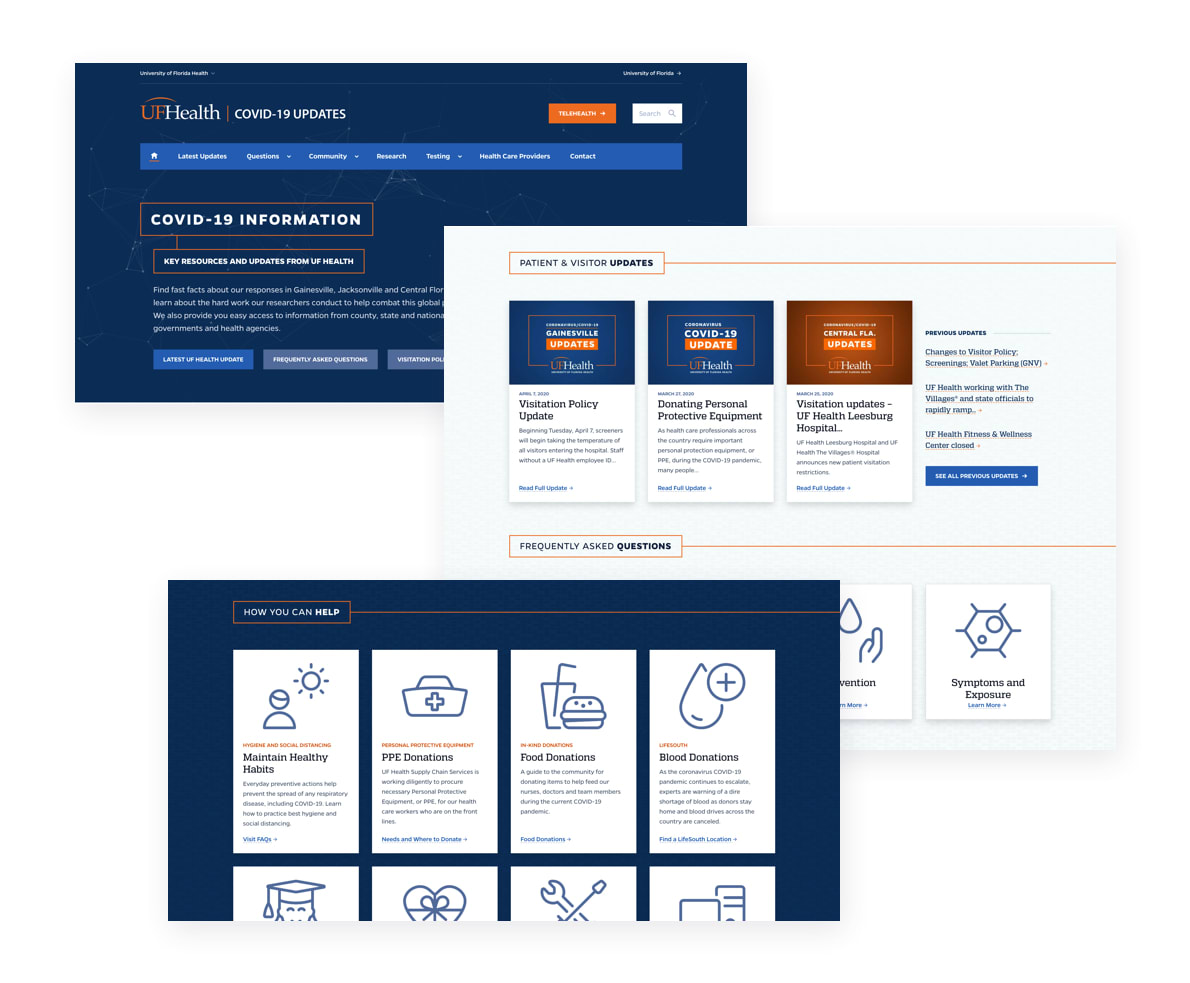
Lesson 1:
The folks in Florida have been working to build a centralized portal for UF Health that tracks updates for hospitals in three different cities, academic information, drive-thru testing in specific locations and research initiatives across campus to develop rapid testing and mask and ventilator alternatives. This is an ever-expanding, cross-collaborative effort from dozens of communicators spread across north central Florida. That collaboration, in and of itself, is tremendous.
Solves for: accessibility, audience range, breadth of messages, delivery efficacy
Why it works: As you know intimately, knowledge is power. Tap the communications systems and skills of cross-team colleagues and peers to deliver new and powerful information.
Lesson 2:
Coronavirus.ufhealth.org provides a “How You Can Help” section, giving people steps they can take like where and how to donate blood, PPE opportunities and knowledge-sharing through the Folding@Home site.
Solves for: audience range, breadth of messages
Why it works: There is universal anxiety in the air right now, and this situation has shown how eager most of us are to help others. Give your audiences opportunities—whether through your institution (e.g., emergency student funds) or off-campus channels—to support people who are suffering.
Lesson 3:
The university’s COVID-19 response site is very clean and modern.
Solves for: accessibility, delivery efficacy
Why it works: This pandemic requires all of us to show up for each other in top form, and that can be expressed via our website design and UX capabilities. Take time to test all iterations of your site before going live, and make sure they are accessible and mobile friendly.
Example of note: University of Rochester
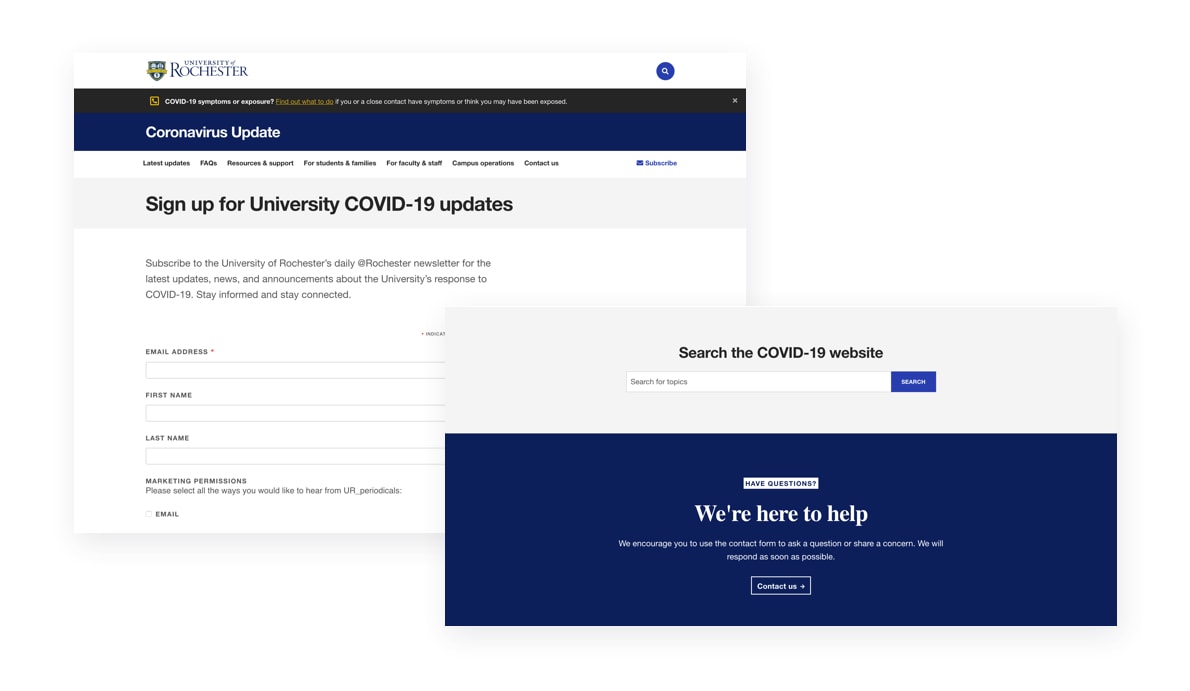
Lesson 1:
University of Rochester offers a subscribe option so people can sign up for updates delivered straight to their inbox, rather than having to repeatedly visit the site. (Full disclosure: We’re currently collaborating with other offices at the University of Rochester, but we haven’t been involved in this initiative.)
Solves for: accessibility, delivery efficacy
Why it works: This option eliminates a step for audience members, helps them trust they will get the information they seek in a timely manner and supports audiences who might feel overwhelmed by the website. Provide an easily accessible opt-in framework for delivering updates beyond traditional email segmentation.
Lesson 2:
The university’s coronavirus website has a “Search the COVID-19 website” function.
Solves for: accessibility, audience range, delivery efficacy
Why it works: It’s difficult to serve up every answer and detail for every audience in one page. Add a search option that’s limited to your crisis communications content to empower visitors looking for specific information.
Example of note: Stanford University
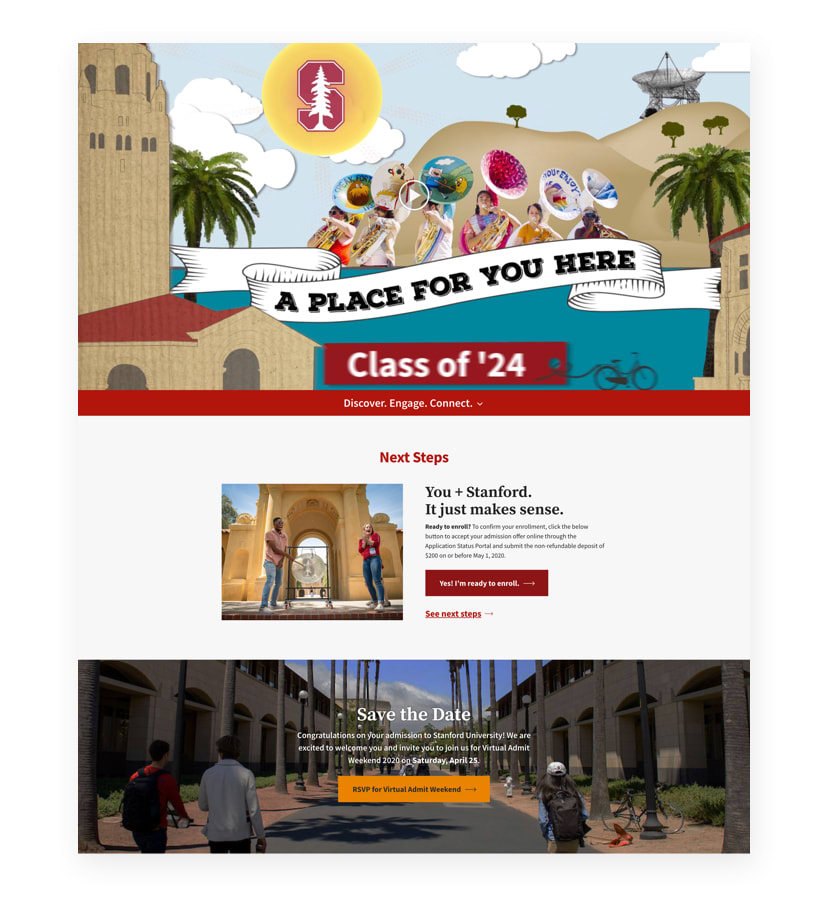
Lesson:
Stanford’s traditional Admit Weekend event has been canceled due to the pandemic. To replace this essential event, the university collaborated with our team to create a virtual version for admitted students to experience what sets Stanford apart from other schools they may be considering.
Solves for: audience range, breadth of messages, delivery efficacy
Why it works: This online Admit Weekend gives students and parents the information they need to make a decision while fostering a personal connection so students can imagine themselves at Stanford. It includes a map of admitted students, a VR tour and a week-long schedule of interactive events comprising streamed broadcasts (with a live Q&A integration) and Zoom video chats for smaller events. Stanford managed to not just provide a substitute for the “real thing,” but create an immersive digitally native experience for its #Classof2024. Develop digital experiences that facilitate continuous content creation and engagement.
Best practices you can start immediately
Based on our conversations with higher education communications teams and our site evaluations, we’ve narrowed in on three actionable solutions for these nebulous and multi-layered pain points.
Create a plan that streamlines centralized messaging control.
Every department, organization and unit feels compelled to communicate with their constituents. Fair. Show those teams you respect that intention and the people they support. But. Now that we’ve settled (as much as possible, anyway) into our homebound new world, the opportunity is here to develop a college-wide communications system specific to COVID-19 variables.
Provide examples of what can happen, logistically and emotionally, if there’s not a centralized messaging control, like HR sending instructions for staff to sign up for work shifts and resources when the managers hadn’t been briefed on updated processes, or academic departments planning virtual ceremonies when commencement decisions had yet to be made at the institutional level.
If you don’t have the humanpower to staff the ideal communications plan, offer your teams tools of support. Plan several months out to prepare for what will need to be decided and communicated online, and be specific about who is responsible for the communications, how the information will be shared and what other departments may be affected. Finally, position your messaging control work as what it is—a solution for your institutional peers and a chance to give audiences the best experience possible.
Expand your centralized repository of all things COVID related.
Some of the organizations we reviewed had additional resources for veterans, financial aid, housing and more that weren’t linked on their COVID-19 central response hubs. That’s a major miss. There’s enough stress on audience members right now. Imagine finding out later that there was a financial aid option available, and you missed the deadline because the information just wasn’t where you expected it to be.
Document a communications workflow to respond quickly to future COVID-19 developments.
The higher education professionals we’ve talked to who have felt most successful during this crisis commonly cited two reasons for their success: 1) having cabinet-level presence or representation and 2) having the ability to build a consolidated messaging flow that routed through a single person or office extremely early in the process. These reasons for success, though perhaps not sustainable for all situations, are veritable case studies for a moment unlike any we’ve seen before. Use them to inform your revised COVID-19 communications plan.
Through it all, we’re grateful for this: You work in higher education because you care. There’s something about the goodness of learning, the social change enacted in these spaces, the transformational power of knowledge-sharing, that brought you to this work in the first place. We see that commitment in every higher education collaboration we’ve had. This is a chance to leverage your expertise and your passion to support teams, help your communities, inspire students and (of course) more.
We’re here to back you up.
If you need a fresh pair of eyes, ears or brainpower on challenges your college or university is facing during the COVID-19 pandemic, Modern Tribe wants to help. Here are some ways we can support your team:
- Join or lead a brainstorm with your team
- Act as a sounding board for any ideas you’re considering
- Help you build a case to take to your leadership team or provide some best practice examples to support your plan
- Review your roadmap and identify tech solutions that can help get you through this period of social distancing and beyond
Feel free to reach out to our leadership team at [email protected], and we’ll set up some time to chat.
